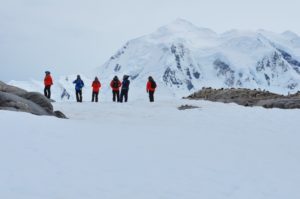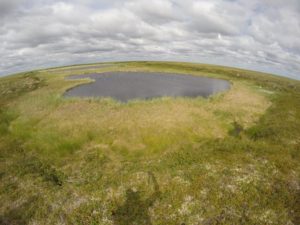June 22, 2020
Allies and Community Are Crucial for Science. Here’s why.
Posted by Caitlin Bergstrom
Heidi Steltzer is a lead author of Intergovernmental Panel on Climate Change’s (IPCC) September 2019 Special Report on the Ocean and Cryosphere in a Changing Climate, a 2018 Voices for Science Advocate and a professor of environment and sustainability at Fort Lewis College in Durango, Colo.
This is part one in a series around diversity in the Earth and space sciences. We encourage everyone to read parts one and two of this series on creating inclusive spaces for women of color. “We demand better for our community and for the future of our society and the planet. Together, we can build a thriving, sustainable and equitable future for all.” Read AGU’s From the Prow statement here.
In the Earth and environmental sciences, there’s a world of change still needed for inclusion of people of color, people across the full spectrum of sexuality and gender, and people with disabilities. Determined action in our world to protect people and planet cannot take place without a sea change within the culture of science. Allyship and community are crucial for this.
A few years ago, I returned from a leadership expedition in Antarctica for women in science with a glimmer of new understanding about gender issues in science. Over the 20+ years of my career, I had normalized discrimination for myself and for other women, accepting that I should rarely ask for and never expect help. In the trailer for a film that features our expedition, Dr. Sarah Charnaud states this well, “I’ve never asked for a raise. You are lucky to get what you are given”. Perhaps, our expectations needed to change.
Therefore, when I needed help that summer to complete a grant-related task, I reached out to a person at my institution who knew how to complete the task. It was a simple task though I didn’t know how to complete it. They said no. Since the task had to be completed, I asked someone else for help. They agreed and it was taken care of in a few minutes. However, the person who helped me said the first person I asked should be the one to help. This task would need to be done again by me and others who had grants. Would equitable support be assured?
In science and higher education, we often compel the individuals who face barriers to change systems. A faculty’s research— in this instance the best research opportunity of my career—could be held hostage, necessitating the faculty bring about a solution. Yet, this was part of a systemic issue of inequity at my institution and many others. Due to a lack of equity, science and academia constantly loses people who would diversify our community. If I was not able to get help for a simple task, how would the request to eliminate barriers to equity be met?
That summer, I made choices to ask for help and support others in bold ways, meeting resistance with nearly every step. I still thought that if I ‘leaned in’ and if my actions were constructive and I spoke up, then change would be possible. But, cultural change cannot be undertaken alone, especially if one lacks power. We need support, though sometimes we may need to act alone and be an ally when no one else will. In Alaska, in a field program that’s intent was to increase diversity in the Earth and environmental sciences I found myself in precisely that situation.
In a tundra landscape where the sun never sets and lakes disappear as frozen ground thaws, I realized a student was being discriminated against. She is Yupik, and we were conducting research in her homeland. She wanted to help her community and was being denied equal opportunity to conduct research in a rapidly changing tundra landscape. She had generations of knowledge about the land, the lakes and the rivers to share, but wasn’t given the chance. Ostensibly, the student’s purpose was aligned with the program’s. Biases, which are often implicit, led to this disconnect and to unintended harm.
I supported the student and repeatedly spoke up, but was repeatedly shut down. We were left with just one choice. We let the faculty know that we could not stay and left the program. The student left science. Though I considered leaving, I chose to stay to invest in community.
We must tackle the systemic biases and discrimination in science that racism, sexism and ableism engender. This must be done together. We must choose to act heroically as the Earth and environmental science community. As we live through another destructive climate year, there is a global pandemic taking place. The land, seas and their inhabitants are being lost, while far too many decisions lack the insights of science. A herd of black elephants is stampeding towards us – environmental catastrophes about which we, as scientists, know that are likely to take place soon. Cultural change in science will need to be swift and can be if we act together.
We can each begin by recognizing that our experiences in science and academia may be very different from others. Race, culture, gender and trauma influence how people behave towards one another and perspectives of these behaviors. A firm handshake may be unwelcome. “First come, first serve” may not be possible for those from cultures who value restraint. Cooperation fosters inclusion, whereas competition does not. Someone who helped you may have harmed others, and whether intentional or not, they need to do better. We will need to change practices to ensure conversation rather than tolerance follow harm. Science itself can look and feel different and still be science. Science can be community-based and narrative-rich.
After leaving the field site, the student and I returned to her community. We walked gravel streets and hidden paths together. She shared insights through allegory, stating that Yupik folklore is that the lakes we were studying had been formed by sleeping giants. I pictured these giants with two legs, huge shoulders and long arms, laying across the land in different ways to create the immense diversity of size, shape and connectedness of the lakes. But, cultural bias had limited my thinking. The tale involved more than people.
The tundra lakes were formed by a diverse community of many species of which her people and mine were equal parts. All the Earth’s inhabitants shape the land and waters on our planet, each in their own way. By restoring balance among species, and across race and culture, catastrophes can be averted. Allyship and community can nurture the cultural changes in science that are essential for our science to achieve its purpose of a more just and sustainable world.



